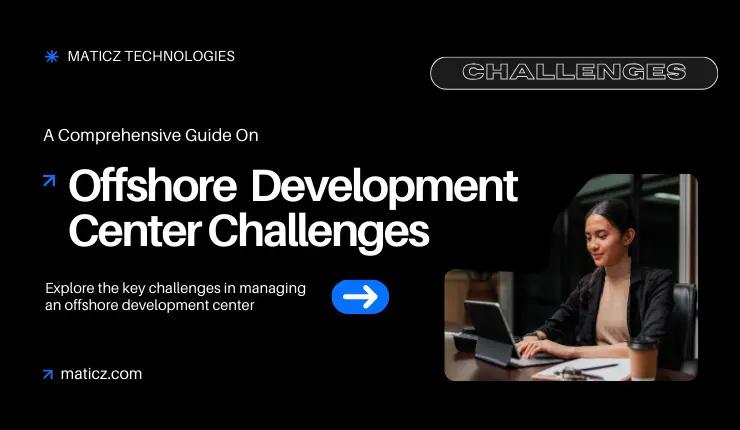Share Posts

Challenges in Managing an Offshore Development Center (ODC)
46
1884
103
Startups look at the Offshore Development Center (ODC) as a golden opportunity for faster growth at lower costs. While the benefits are appealing, running an ODC might provide unanticipated challenges. It presents numerous problems such as differences in culture, and time zone, along with hidden costs.
In this blog, we will look at the most common challenges that arise when running an offshore development center. If your startup is considering or is already working with an ODC, these insights can help you negotiate the challenges and make the most of your offshore setup. Let's get started.
Challenges in Managing an Offshore Development Center
1. Data Security
Data security is a major concern for any offshore operation. Sharing sensitive information across borders increases the risk of breaches. This opens up vulnerabilities, with potential exposure of confidential data. Securing information and preventing unauthorized access become ongoing challenges.
2. Cultural Differences
Cultural differences impact work style, communication, and feedback methods. What is polite or acceptable in one culture might seem unprofessional in another. Misunderstandings arise from varying approaches to deadlines, teamwork, and hierarchy. Small cultural clashes can build up and affect productivity. Bridging these cultural divides is often time-consuming and can disrupt workflow.
3. Communication Gaps
Time zone differences lead to delays in response times and updates. Language barriers can cause misunderstandings of project details or instructions. Limited face-to-face interactions reduce opportunities for real-time feedback and clarification. This gap can lead to mistakes or missed deadlines. Miscommunication often leads to extra time and effort spent on corrections.
4. Quality Control
Ensuring consistent quality standards across multiple locations is a tough task. The offshore team may lack access to the same tools or benchmarks as the in-house team. This can result in inconsistent quality or performance gaps in deliverables. Quality assurance becomes a bigger issue as both teams may interpret standards differently. Keeping the final product up to par becomes more challenging over time.
5. Integration with In-House Team
Offshore teams often feel disconnected from the main office, impacting morale and productivity. They may miss out on important company updates, team-building, and the larger company vision. This distance creates a sense of isolation, making collaboration harder. Offshore members may feel like they are on the outside, impacting engagement. Achieving seamless integration with the in-house team is often difficult.
6. Project Management
Managing projects with geographically dispersed teams is complex and demanding. Tracking tasks, milestones, and accountability becomes harder without in-person supervision. Progress can be difficult to gauge, and small issues may snowball into major delays. Offshore project management demands constant updates and check-ins to stay on track. This setup adds more responsibility to managers, increasing their workload.
7. Legal and Regulatory Compliance
Every country has unique data protection, labor, and business laws. Compliance with these standards can be challenging, particularly in international countries. Even minor regulatory violations might lead to serious legal consequences for the company. Keeping up with new legislation takes effort and requires continuous monitoring. Legal risks complicate the management of an ODC.
8. Hidden Costs and Overheads
Offshore centers are often seen as cost-effective, but hidden costs can mount. Travel expenses, software licensing, infrastructure, and equipment maintenance add up. These expenses strain the budget and can make the setup more expensive than planned. Unexpected costs disrupt cash flow, especially for startups with limited funds. Estimating the true cost of an ODC is challenging due to these overlooked expenses.
9. Loss of Control and Oversight
Offshore teams mean less direct oversight, making it harder to monitor daily activities. Managers may feel they have limited control over productivity, workflow, and task quality. This loss of visibility can impact deadlines, quality, and team morale. Ensuring team alignment and tracking progress is a major hurdle without on-site supervision. Remote oversight requires more effort and regular updates.
10. Dependency on External Providers
ODCs often rely on third-party providers for key services like software and the Internet. If a provider faces downtime or disruptions, the entire offshore team’s productivity is affected. This dependency creates vulnerability, as the team’s performance is tied to external factors. These disruptions can slow down projects and cause missed deadlines. Relying on external providers adds uncertainty to daily operations.
Tips To Overcome Challenges Of Managing ODC
1. Make sure to use encryption and secure communication tools. Provide regular cybersecurity training for your team.
2. Set up clear communication channels and hold regular meetings to keep everyone informed.
3. Plan training and team-building activities to promote awareness and appreciation of different cultures.
4. Define clear quality standards and conduct regular checks to ensure consistent deliverables.
5. Use software to track progress, define roles, and manage tasks effectively to improve accountability and productivity.
Wrapping Up
Managing an Offshore Development Center (ODC) comes with its own set of challenges. Hope this blog has uncovered some of the important challenges you might face if you were to set up and manage ODC. These obstacles can have a direct impact on your productivity, project timelines, and budgets, putting your startup at risk. But with the right ODC partner, these challenges become much more manageable.
Maticz specializes in creating successful offshore teams for startups just like yours. We have a pool of talents with the technical expertise and experience required to manage an ODC and overcome the challenges associated with it. Whether you want to scale up your workforce or need specific expertise, we have got you covered. Collaborate with our top talents and witness long-term success.
Tap Into the Future
The latest insights, posts, and project updates - straight to your inbox.




